| Article ID | Journal | Published Year | Pages | File Type |
|---|---|---|---|---|
| 1201485 | Journal of Chromatography A | 2011 | 8 Pages |
The aggregation and adhesion of bacterial cells is a serious disadvantage for electrophoretic separations of bacteria. In this study, lipid-based liquid crystalline nanoparticles were used as a pseudostationary phase to minimise the bacterial aggregation and adsorption to the inner walls of microchannels. Lactobacillus delbrueckii subsp. bulgaricus, Streptococcus thermophilus and Lactobacillus rhamnosus were selected as analytes and were separated by microchip electrophoresis (MCE) with laser-induced fluorescence (LIF) detection using 4.5 mM tris(hydroxymethyl) aminomethane (TRIS)–4.5 mM boric acid–0.1 mM ethylenediaminetetraacetate (EDTA) (TBE) containing poly(ethylene oxide) (PEO) and lipid-based nanoparticles as the running buffer. The mechanism of lipid-based nanoparticles affecting bacterial adhesion and aggregation was discussed and supported by zeta potential experiments. Under the optimal conditions, the three species of bacteria were identified with patterned peaks. This proposed MCE method using lipid-based nanoparticles as running buffer additives was also used to analyse a real yogurt sample, and valuable bacterial information was obtained by the electropherograms.
► Lipid-based liquid crystalline nanoparticles were used as a pseudostationary phase and as a stationary phase to minimise the bacterial aggregation and adsorption in MCE. ► The zeta potentials of the bacteria were measured to investigate the mechanism involving the reduction of bacterial adhesion and aggregation in the presence of nanoparticles. ► Three species of bacteria were successfully separated by MCE-LIF under the optimal conditions.
